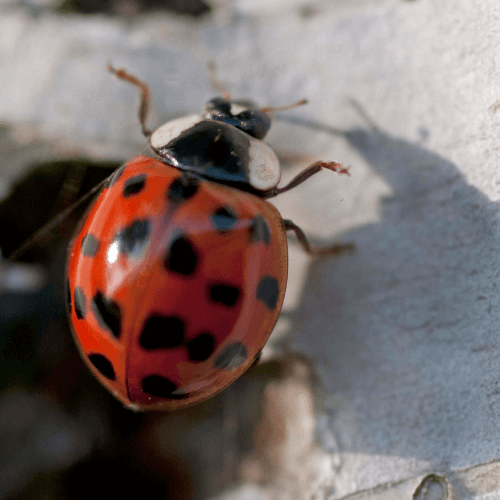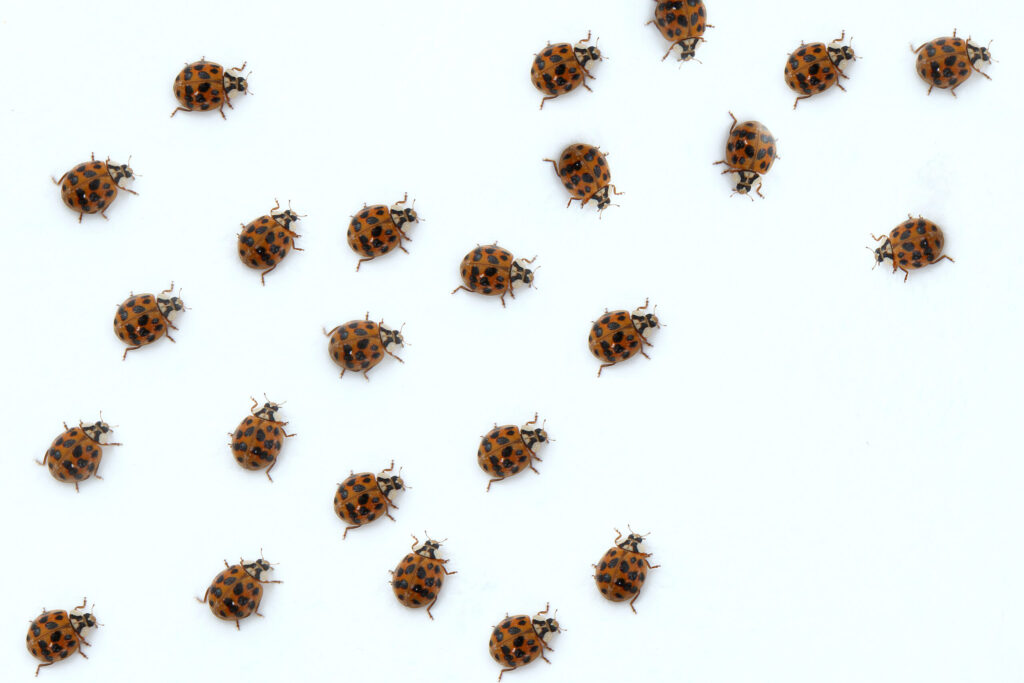Ladybugs may seem harmless, but when they invade your home in large numbers, they can become quite a nuisance.
What you need to know?
As autumn approaches, the adult beetles leave their summer feeding sites in yards, fields, and forests for protected places to spend the winter. Unfortunately, homes and buildings are one such location. Swarms of lady beetles typically fly to buildings from September through November depending on location and weather conditions.
Studies have shown that Asian lady beetles are attracted to illuminated surfaces. They tend to congregate on the sunnier, southwest sides of buildings illuminated by the afternoon sun. Homes or buildings shaded from the afternoon sun are less likely to attract beetles. House color or type of construction (concrete, brick, wood/vinyl siding) is less of a factor for attraction than surface contrast.
As temperatures warm in late winter/early spring, the beetles once again become active. This usually occurs first on the sunnier, southwest side of the building. As awakening beetles attempt to escape to the outdoors, some inadvertently wander inward, emerging from behind baseboards, walls, attics, suspended ceilings, etc. Since lady beetles are attracted to light, they are often seen around windows and light fixtures.

100% Eco-Friendly Options

Adult Asian lady beetles are oval, convex, and about 1/4-inch long. Their color can vary widely from tan to orange to red. They often have several black spots on the wing covers, although on some beetles the spots may be indistinct or entirely absent. Multi-spotted individuals tend to be females while those with few or no spots tend to be males. Most beetles have a small, dark “M” or “W”-shaped marking on the whitish area behind the head.
Signs of a ladybug infestation may include seeing large numbers of ladybugs in or around your home, finding ladybug droppings or stains, and noticing a musty or pungent odor.
To prevent ladybugs from entering your home, seal any cracks or gaps in walls or floors, use weather stripping on doors and windows, and remove any leaf litter or debris from around your home.
Ladybugs are not dangerous to humans and do not bite or sting.
Effective ladybug treatments may include using insecticide sprays or dusts, as well as removing any infested materials from your home. It’s best to consult with a pest control professional for the most effective treatment plan.
Sealing cracks and openings is the most permanent way of preventing lady beetles from entering buildings. The time to do this is in late spring or summer before the adults begin flying to buildings in search of overwintering sites. Cracks should be sealed around windows, doors, soffits, fascia boards, utility pipes, wires, etc. with caulk or other suitable sealants.
Larger holes can be plugged with cement, urethane foam, or copper mesh. Repair damaged window screens and install screening behind attic vents, which are common entry points for the beetles. Install tight-fitting door sweeps or thresholds at the base of all exterior entry doors. Gaps of 1/8" or less will permit entry of lady beetles and other insects. Gaps under sliding glass doors can be sealed with foam weather stripping. These practices will also help prevent the entry of flies, wasps, crickets, spiders, and other pests.
Indoor Treatment - Insecticide sprays are generally not recommended for eliminating beetles indoors. A better approach is to take preventive measures to reduce beetle entry.
Outdoor Treatment - While sealing cracks and openings is a more permanent way to limit beetle entry, the approach is time-consuming and sometimes impractical. There can be countless cracks associated with eaves, siding, vents, etc. where insects can enter. On multi-story buildings, sealing becomes even more difficult. Schedule your exterior barrier treatment today!
Copyright © 1st Choice Pest Control 2024 - All Rights Reserved. developed By Sleeks IT Solutions